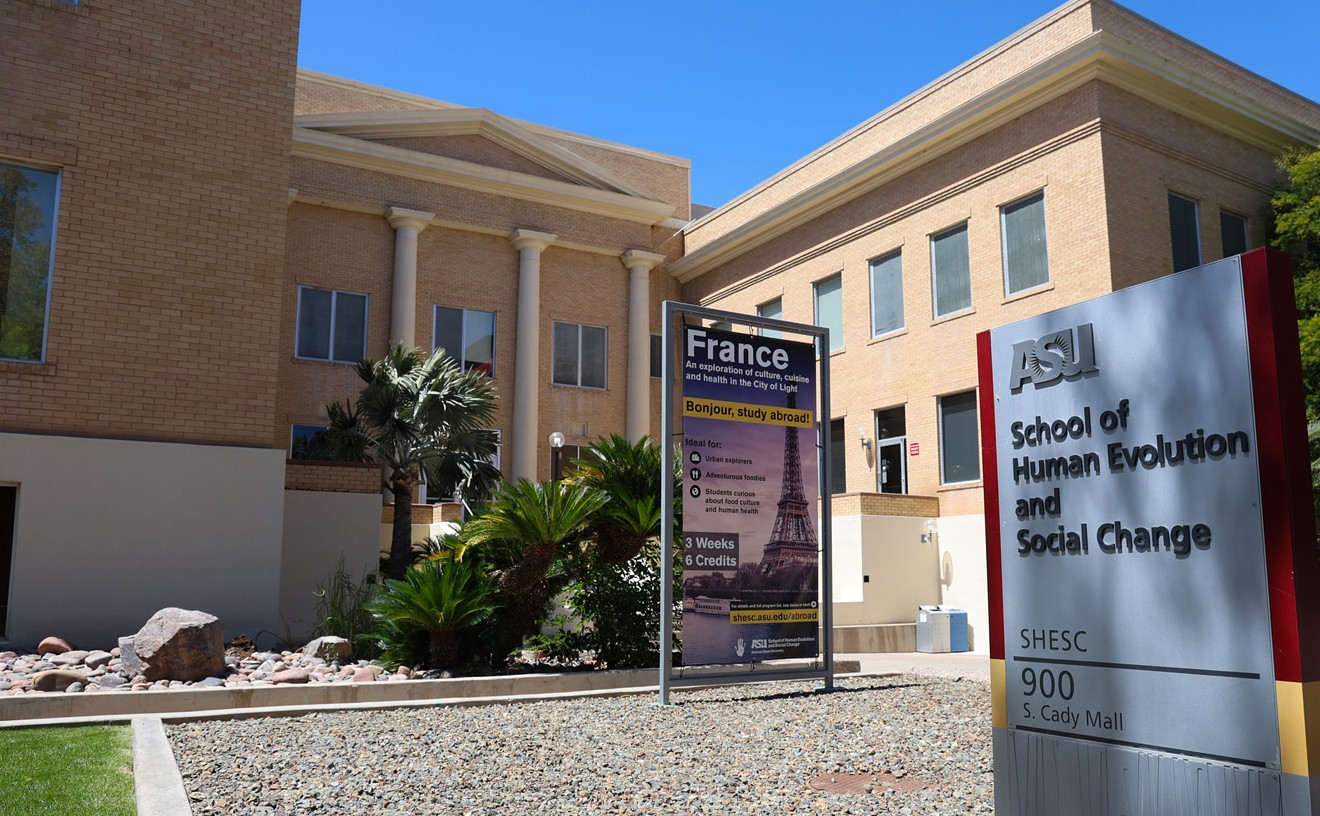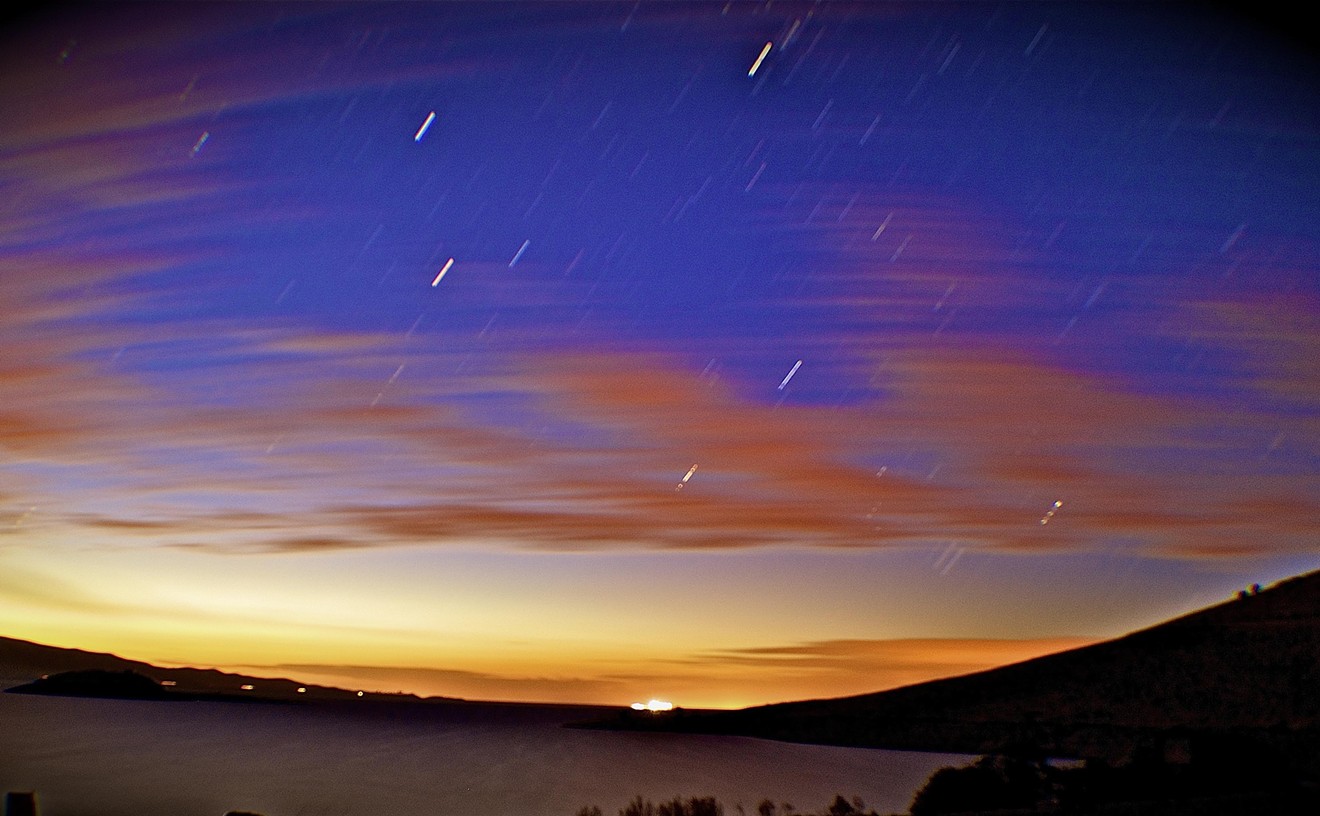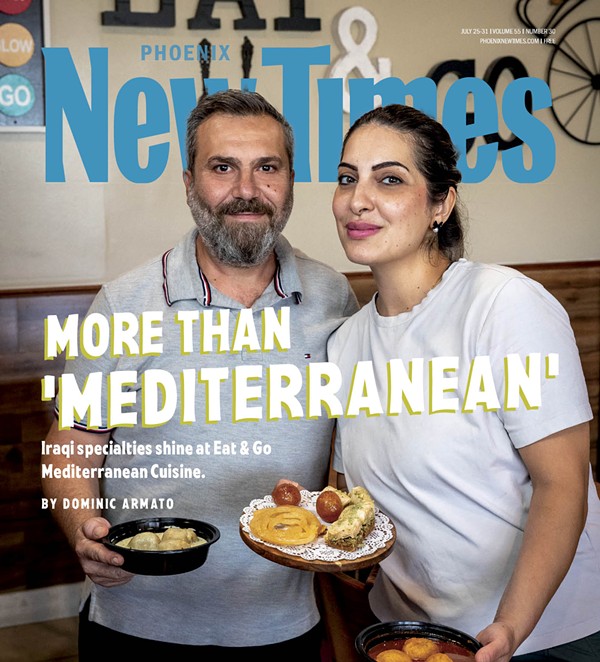On the building's outer east wall is a sun-baked mural of the seven African powers surrounding their divine savior. Inside, one can purchase religious icons, bits of African folk art, candles, oils, rosaries, shrines, herbs, and, at varying degrees of price, direction from the spirits.
The religious practice at Las Potencias is Santeria and its so-called dark side, Palo Mayombe, both of which are used here to ward off or cleanse evil spirits.
Manning the place is 55-year-old Estefana Ramos and her 40-year-old son, Thomas Baldonado. Ramos is, in a manner of speaking, a priestess of Santeria.
Baldonado is -- after years of intense study -- a father (Tata) in the Palo Mayombe religion. And both mother and son are, for lack of a long and involved explanation, kinds of "vibe merchants." Both study regularly and dedicate hours every day to prayer and meditation.
Santeria combines West African religion (born of native Yoruba deities) and European Catholicism. During the 19th century, tens of thousands of Africans were yanked from their homes and sold into a life of anguish as slaves in the Americas and the Caribbean. And despite the attempts of slave owners and missionaries to convert the slaves to Catholicism, their religion stayed intact. As the consequences of practicing their creed wore on, African slaves toiling in Cuba -- in an act of self-preservation -- fused elements of Catholicism to their own religion. The slaves cloaked their African gods and goddesses -- called orishas -- in the imagery and façade of Catholic saints.
Now, a person practicing Santeria sees no boundary between Santeria and Catholicism. To a Santerian, the Catholic saints and Santeria orishas are interchangeable. When a Santerian worships a Catholic saint, he is automatically worshipping the compatible orisha.
Santeria and Palo Mayombe aren't voodoo like many presuppose, either, though each evolved in the New World from African faith traditions. Voodooists do, however, worship some of the same gods as Santerians.
Santeria and Palo Mayombe differ in marked ways. Palo, in short, is a direct method of communication with the spirits: the belief is akin to shamanism. The most relevant spirits for Palo are the spirits of the Dead, the spirits of Nature and the Highest Entities that manifest themselves in the forces of nature and in man. Santeria employs the forces of light. Enlightened Palo Mayombe practitioners -- called "Paleros" -- use the more antagonistic forces of darkness to accomplish their plans and preternatural spells. The Paleros actually call on spirits of the dead. Because Paleros trade in black magic, sundry Santerians tend to avoid being associated with Palo Mayombe.
Which makes the association of the two religions under this one roof seem, at least, unusual.
The front room of the two-room Las Potencias contains baroque Santeria adornments and shrines. On the floor near the front door is Eleggua (St. Anthony) -- a messenger that opens and closes all spiritual doors. On a shelf is a shrine to Chango (St. Barbara), ruler of thunder, passions and power. Filling a corner is an altar for Yemaya (Our Lady of Regla), the ruler of the sea and maternity. Other smaller shrines are propped in the space: Obatala (Our Lady of Mercy), ruler of peace and purity; Oshun (Our Lady of La Caridad del Cobre), ruler of love, marriage, gold; Oggun (St. Peter), ruler of war and work; Orunla (St. Francis of Assisi), ruler of divination.
"These are spirits, and at night they come out," says Mexican-born Ramos of the African powers. "I stay here sometimes at night, and I am not scared. They are beautiful. Everybody [the orishas] has different responsibilities."
When people come to her with a specific problem, Ramos says she uses both herbs and offerings to the Santerian orishas to steer the troubled in the right direction.
"We have many different kinds of problems. We have to counsel them first. Then from there we know what we have to do. Sometimes we have to do a cleaning. So we give them herbs. We use a lot of herbs. We use 21 African herbs to cut down on all the negative in the body. When we have a lot of negative in our bodies, it blocks us from a lot of good things in life.
"There is such thing as evil. There is such thing as black magic and voodoo. Black magic, they come to us and we take it off," she says, waving her hand in a quick sweeping motion, her eyes dark and serious. "And business is good. Why? Because I love to be with different people. We love to help the people. . . . We are already helping people from Houston, from El Paso, from Mexico."
Controversy has always surrounded Santeria, Palo Moyambe and other religions that practice animal sacrifice. This debate has seen its share of the courtroom. One such court battle, ending in June 1993, the case of the Church of the Lukumi Babalu Aye, Inc. and Ernesto Pichardo, Petitioners, vs. City of Hialeah, Florida, reached the U.S. Supreme Court. The court held that these practices alone could not be "prohibited" by legislation that was specifically meant to target religious practices. The Santerians saw this as a victory of sorts.
Opposing groups contend that animal sacrifice is inhumane and should be stopped. Many Santerians say eating a Whopper with cheese is a far crueler example of animal sacrifice. To Santerians, animal sacrifice is an essential part of their religion. Usually, small animals are sacrificed during sickness or initiation ceremonies for priests. They contend that the animals are usually killed in a humane way and eaten later.
"Palo Mayombe is different because in Santeria you ask for the blessings," says Thomas Baldonado, being careful to avoid using words like hex and black magic. Baldonado has big trusting eyes and a white smile. Strung over his left shoulder is Collares de la Bandera -- a string of multicolored beads and small shells that is said to be all powerful when interacting with the spirits. "When you ask any Santerian about a person who is Paleros, they will say negative things about them because they work in a cemetery and they work with the dead."
Often, dirt and powder used in Palo Mayombe spells are found in cemeteries. Some powders are derived from the bones of the deceased (Hueso de Muerto) or cemetery-crawling spiders (Polvo de Arana de Cemeterio).
Baldonado says Paloans believe "everybody has an orisha. . . . You don't have to be Santero but you can talk to one of the saints. It is universal.
"In Palo you're brought into it and you're part of the family. It's like a big gang. We are all praying for the same things so we got all this force, this energy that's coming from an isolated place. But Santeria and Palo are part of the same thing. But in Palo we work with, I don't want to say negative force, but the more aggressive force."
Baldonado is decidedly cheerful and chipper for a guy who says he regularly communes with spirits. And he is confident that he helps people, that what he does is compassionate. He says most people seek out his service for guidance and direction, noting that everybody has a gift -- some just don't know it.
Women come to him to calm the wanderings of cheating husbands. Men come looking for help in getting laid.
"We get doctors, lawyers, white people, Mexican people, herbalists. Some just want love. When somebody comes in here and it is their nature to have somebody just tell them that it is going to be okay . . . they are gonna feel like it was worth the $20 just to be told that. But a lot of times, just by looking at the person, you can tell that this person doesn't need to be here. What they need is somebody to talk to or a friend or a psychologist. Some people come in here and say, 'Oh man I am hexed. You have to remove it.' I just say, 'Go home, take it easy and get some rest."
Palo Mayombe offers up many spells: hexes to protect your home from your enemies, to destroy an enemy, for protection on the streets, to attract love, for revenge (divine justice), for wealth and prosperity, to cause another to have conflicts, to make a man impotent and so on. There are spiritual consultations, myriad initiations and, of course, animal sacrifices.
The back room at Las Potencias is the Palo Mayombe room. Framed imprimaturs of the 11 primary spirits of the underworld frame a shrine on one wall. There are black candles, herbs in jars, African masks, various sticks and other accoutrements used in divination ceremonies, offerings, spiritual cleansings and ritual sacrifices. A bowl encircled by water-filled goblets is meant to calm the spirits of the dead. A safe houses Baldonado's secrets and, from what we gather, his hexes and spells. He doesn't let us see inside. When asked, he just moves his head from side to side gravely.
Baldonado shakes small seashells and rolls them across the table's doily as if he is tossing craps. He starts in with a prayer. After a bit he says our name, collects the shells, shakes and throws again. More prayer.
He has made connection with the spirits, and he informs us that they are willing to speak, that they are willing to help. We tell him things we want to know. Simple stuff about life and death. He nods, shakes and tosses. The shells bounce and fall. He reads them silently and nods his head. He tells us general things; things that could apply to anyone somewhat lost in America. But toward the end, he nails us with something so personal that even we are shocked. And our raised eyebrows tell him so. He looks at us and nods with a kind of smile as if to say, "What else?"
Baldonado motions for the next patron to come in from the outer room, a room surrounded by so many faces.










